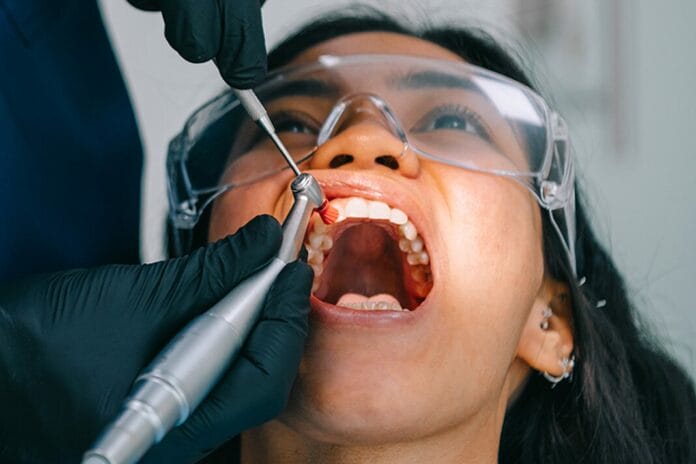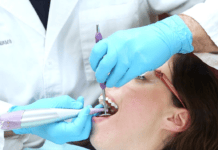The concept of polishing was noted in Roman and Greek writing. It was not until Pierre Fauchard, the father of modern dentistry, associated polishing with stain removal.1 Interestingly, Fauchard used “finely ground coral, eggshells, ginger, or salt.”1 Now fast forward to Dr. Alfred Fones, the founder of dental hygiene, where he educated his “auxiliaries” on providing polishing care.1
During this time, it was found that stains were “not the etiologic factor for any destructive process and hence, removal of stains was for esthetic, not for health reason.”1 This was why Dr. Esther Wilkins introduced the initial concept of selective polishing and only polishing surfaces with visible extrinsic stains decades ago. Currently, more evidence-based research has adopted the concept of selective polishing.1
Selective polishing is more complex than simply “only polishing areas of stain.” It involves the proper selection of polishing or cleansing agents and techniques to achieve a smooth, glossy, and lustrous surface that reduces biofilm deposition.2,3
Does the patient require a polishing agent or a cleansing agent? Unlike polishing agents, cleansing agents are round, flat, nonabrasive particles that do not scratch surface material. However, they produce a higher luster than polishing agents.3
Polishing agents are traditionally abrasive and used to remove extrinsic stains and leave the enamel smooth and shiny. If a polishing agent is chosen over a cleansing agent, the polishing process should progress from coarse abrasion to fine abrasion.3
I have found that either patients love polishing or hate it. For me, I love it, especially when I was growing up. I always chose chocolate chip cookie dough prophy paste. This love influenced me to enter the dental field. To some patients, polishing agents or cleansing agents are just fancy toothpaste. Some patients even think coronal polishing is their “cleaning.”
Polishing and Cleansing Agent Considerations
Not all polishing or cleansing agents are the same, and there is much to consider based on specific patient needs. It also may be the one part of the appointment that a patient may look forward to!
Below are some considerations for polishing and cleansing agents.
Taste
Obviously, this is a huge one. The mint family of polishing agents has run the polishing game for decades. There are other flavors out there, and manufacturers are getting more and more creative – pina colada, sugar cookie, grape, vanilla cupcake! These alternative flavors are not just children-centered anymore. They are for everyone. Some patients plain out do not like mint.
Patient Sensitivities and Allergies to Ingredients
Besides the pleasant taste options a patient may prefer, some patients may have allergies or sensitivities to certain flavors, such as mint or certain fruit flavors. Additionally of concern are nut, gluten, and milk protein allergies, as they can often be very serious and, in some individuals, induce anaphylaxis.4
Studies have indicated allergic reactions to dyes, essential oils, and other additives can cause a range of reactions from contact dermatitis to anaphylaxis. It is essential to review medical history and document all allergens, even those associated with foods.4
Particle Size (Grit)
Polishing agents’ particle size, or grit, is not one size fits all. Have you seen the pattern of this in dentistry? There are many different grits of polishing agents, such as extra fine, fine, medium, coarse, extra course, or straight pumice. Pumice comes in different grits as well. If a patient has heavier staining, such as coffee or tobacco stain, a coarser grit option would aid in stain removal alongside instrumentation. Keep in mind that if you start with coarse, you must follow the progression to fine grit to eliminate scratches on the enamel or restorative material.3
In cases where no extrinsic stain is present, cleansing agents should be used instead of polishing agents. Cleansing agents are powders that are mixed with water to make a paste or slurry for polishing. Some examples would include feldspar and sodium-aluminum silicate.3
Therapeutic Additives
Generally, coronal polishing is not considered a therapeutic procedure, as stain removal is an aesthetic concern. However, some polishing and cleansing agents have additional ingredients, making polishing more therapeutic in nature.3
The addition of fluoride or fluoride and amorphous calcium phosphate (ACP) may help reduce dentinal hypersensitivity and aid in remineralization. Xylitol is also an additional ingredient. It should be noted that polishing with an agent that contains fluoride and/or ACP does not replace fluoride varnish treatment.3
In some instances, a patient may request not to have a fluoridated polishing agent used on them. In some offices, pumice or unflavored would be the only available options. Although unflavored is still a good option in some cases, there are good flavored, non-fluoridated polishing agent options.
When to Polish
Are you polishing before or after instrumentation? Though this may seem like a personal decision, it is important to understand that polishing with a polishing agent is strictly meant to remove stain, not biofilm, and to create a smooth surface resistant to biofilm accumulation. Ultrasonic instrumentation may be a better choice for biofilm removal at the start of an appointment.3
Nonetheless, using a cleansing agent rather than a polishing agent is most appropriate if you polish first for biofilm removal purposes. Additionally, polishing again after instrumentation has been completed may be necessary to remove remaining stains or scratches made during instrumentation to achieve the smooth, lustrous surface that polishing is meant to create.3
Polishing Contraindications
There are a few contraindications to consider when deciding on a polishing agent or cleansing agent. Areas of demineralized white spots should not be polished with an abrasive polishing agent as it removes more surface enamel and can interrupt enamel surface remineralization.3
An abrasive polishing agent is also contraindicated in enamel hypoplasia, hypomineralization, amelogenesis imperfecta, exposed dentin, and cementum. A cleansing agent or fine grit polishing agent would be a better choice for these conditions.3
Dental restorative materials provide another challenge in polishing as the use of coarse polishing agents may create deep scratches in some materials. Selecting the appropriate cleansing or polishing agent depends on the type of material. It is best to follow the recommendation made by the manufacturer of the material when that information is available. In the event the manufacturer instructions are not available, it would be best to err on the side of caution and use a cleansing agent or a fine grit polishing agent rather than a course polishing agent.3
Other Considerations
Prophy angle and handpiece choice are other considerations when it comes to polishing. Another consideration is polishing techniques, such as using a traditional rubber cup or air polishing.
Prophy Angles
Like prophy pastes, there are many options for prophy angles, too. There are three different types of prophy angles: standard disposable, disposable with an abrasive impregnated rubber cup, and stainless steel prophylaxis angle.3
Some prophy angles help reduce splatter, and some have different-sized rubber cups with or without ribbing, firmness, and body designs. Rubber cups, bristle brushes, and rubber polishing points are options, too.
The body design can be a 90-degree angle or contra-angle. Contra-angle disposable prophylaxis angles come in a variety of designs. Some have longer shanks, while others have a wider angle between the prophy cup and shank for better access to tough-to-reach areas. Choosing the proper prophylaxis angle will make the clinician’s job easier and the patient’s experience better.3
One important factor is the flaring of the rubber cup, which can help with access. Rubber cups made of natural rubber adapt better to the contours of the teeth, while synthetic cups are stiffer and do not contour the teeth as well. Be mindful of any latex allergies when choosing the appropriate rubber cup.3
Bristle brush prophy angles remove stains from deep pits and fissures and can be used on tooth surfaces away from the gingival margin. Bristle brushes are contraindicated for use on exposed cementum or dentin.3
Rubber polishing points are very flexible and allow easy adaptation of the tip to a variety of surfaces, such as proximal surfaces, embrasures, and around orthodontic brackets and bands.3
The proper selection of rubber cups, bristle brushes, or rubber polishing points is imperative to achieve successful stain removal.3
Handpieces
Think about your handpieces. Are they corded or cordless? Is it in a location that is ergonomic for you when you are using it? Is the handpiece itself ergonomic in your hand when it is in use?
If it is a corded handpiece, is it overly heavy in your hand? Is the cord too short or causing drag, thus creating additional resistance and increasing muscle workloads? Using a heavy, twisted cord again and again each day may negatively affect your hand and wrist.5 Just like our instruments, handpieces should be lightweight and ergonomic.
Air Polishing
Another mode of polishing is the use of an air polisher. It has been shown that air polishing can reach more difficult areas compared to traditional polishing (rubber cup).1
In this mode of polishing, a water-powder slurry under air is created to remove the stain. It has been noted to be time efficient, time-saving, and reduce clinician fatigue.1 On the other hand, it produces aerosols, which need to be controlled and addressed.
In Closing
A good way to start integrating new and different polishing and cleansing agents is by requesting samples from manufacturers. Often, this can be done simply by visiting the manufacturer’s website or reaching out to customer service. Your office’s dental supply rep may have samples on hand, too. Test-driving different product options enables you to find what works best for you. Your patients can also give you valuable feedback.
Whichever specific products and polishing technique you decide on, remember it is not a one-patient-fits-all model!
Before you leave, check out the Today’s RDH self-study CE courses. All courses are peer-reviewed and non-sponsored to focus solely on high-quality education. Click here now.
Listen to the Today’s RDH Dental Hygiene Podcast Below:
References
- Sawai, M.A., Bhardwaj, A., Jafri, Z., et al. Tooth Polishing: The Current Status. Journal of Indian Society of Periodontology. 2015; 19(4): 375-380. https://www.ncbi.nlm.nih.gov/pmc/articles/PMC4555792/
- Tungare, S., Paranjpe, A.G. Teeth Polishing. (2022, September 26). StatPearls. https://www.ncbi.nlm.nih.gov/books/NBK513328/
- Doucette, H., & Boyd, L. D. (2023) Extrinsic Stain Removal. In L. D. Boyd & L. F. Mallonee, Wilkins’ Clinical Practice of the Dental Hygienist (14th ed., pp. 787-804). Jones & Bartlett Learning.
- Coimbra, L., Costa, I.M., Evangelista, J.G., Figueiredo, A. Food Allergens in Oral Care Products. Scientific Reports. 2023; 13(1): 6684. https://doi.org/10.1038/s41598-023-33125-y
- McCombs, G., Russell, D.M. Comparison of Corded and Cordless Handpieces on Forearm Muscle Activity, Procedure Time and Ease of Use During Simulated Tooth Polishing. Journal of Dental Hygiene. 2014; 88(6): 386-393. https://jdh.adha.org/content/88/6/386












